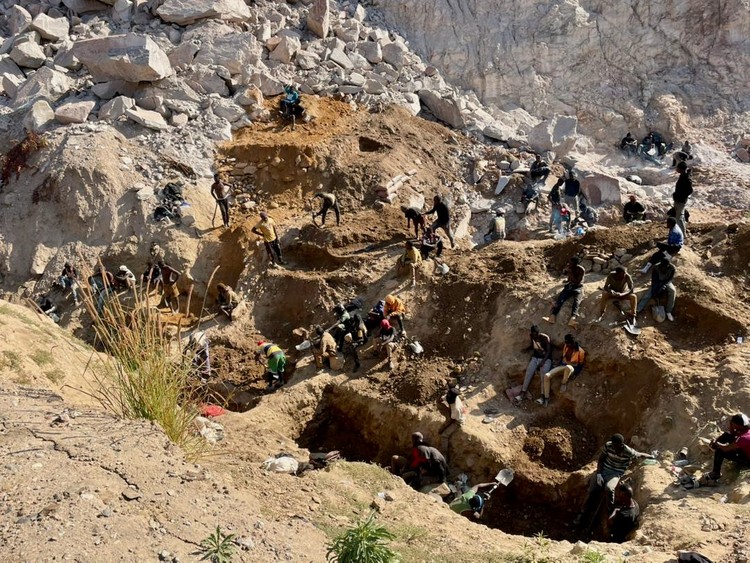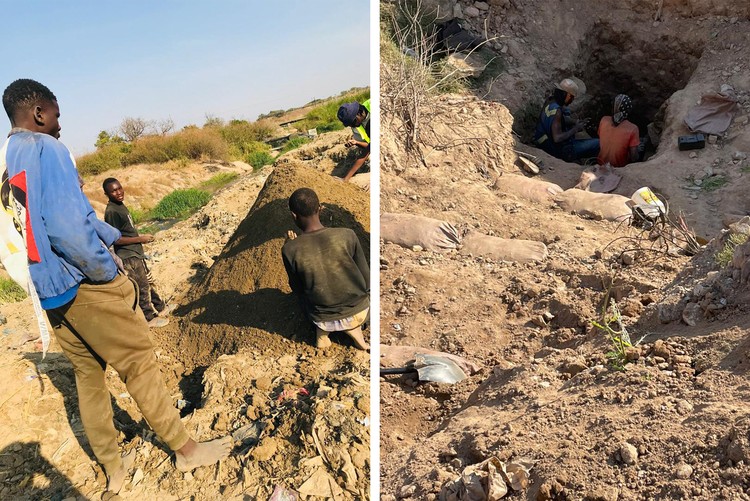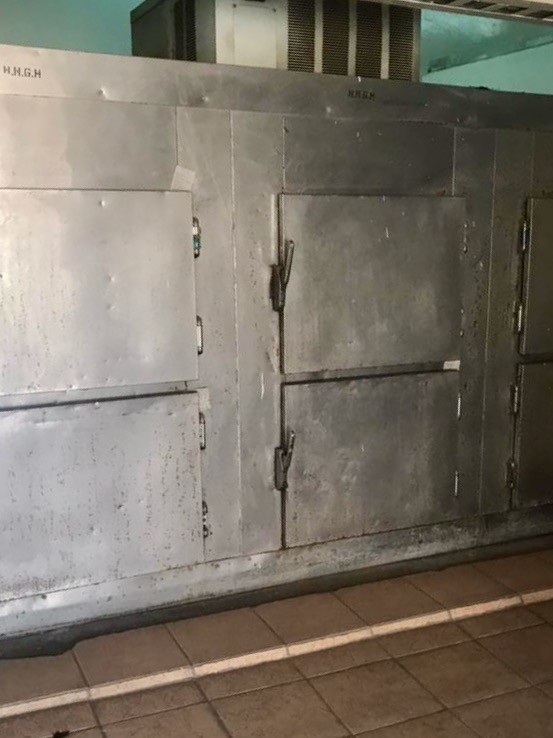Child miners risk death in Zambia’s copper pits
Police rescued 38 children from Sensele Mine in July
The copper-rich pits of Sensele Mine draw informal miners, including children, who risk death for meagre pay. The deadly accidents that follow raise concerns about lax mine security and whether influential figures are ignoring the danger while quietly profiting from it. Photos: Beverly Subeti
Drawn by the promise of quick money, young men, many still in their teens, risk their lives as illegal miners in Zambia’s dangerous copper mines. Politically connected people profit from this, while state institutions grow weaker. This illicit mineral trade extends beyond Zambia, forming part of a wider cross-border network across Southern Africa.
Mourners gather at a grave on the outskirts of Chingola, Zambia. They are burying 21-year-old Paul Chishimba, one of three informal miners killed when a pit collapsed at Sensele Mine in early July. The other two killed were boys, just 14 and 16 years old.
We interviewed Chishimba’s grandmother at her home in Mikiloni township, near the mine. She said the pit was the only source of income for her grandson and many other children in the nearby informal settlement.
“It wasn’t even a deep pit … The ground gave way and buried all three of them. I don’t know exactly what happened. I was only told that Paul was trapped,” she said.
The man who hired Chishimba and his friends to extract copper from the pit paid for the funeral and provided food and transport for the burial. But the family says they do not know his name, only that he lives in the area. The families of the two boys would not speak to us.
A businessman involved in mining claimed that many people die mining, but hospitals often log these deaths as traffic accidents to avoid scrutiny.
Staff at Nchanga North General Hospital told us they have observed a steady increase in “brought in dead” (BID) cases. As at 22 July, the hospital’s mortuary had recorded 116 BIDs for the month, of which only five were officially linked to mine accidents.
The medical superintendent, Dr Charles Chishimba, requested we send a formal query. We asked for mine-related death statistics and whether the hospital reports these to the ministry of mines. He never responded.
A hospital source, who asked not to be named, said bodies from illegal mining accidents arrive in bad condition. The ages of the dead vary, they said, from about 14 to 35.
Children as young as 14 are popular recruits because their small bodies allow them to get into narrow underground tunnels. Using only picks and shovels, they risk their lives for around K100 (about US$4 or R70) per day.
Mining insiders say children as young as 14 are sought after because their small bodies allow them to get into narrow underground tunnels. Using only picks and shovels, they risk their lives for around K100 (about US$4 or R70) per day.
Ministry of Mines and Minerals Development Permanent Secretary Hapenga Kabeta, interviewed in Lusaka, said security at any private mine lies with the licence holder, not the ministry.
“Sensele [Mine] is licenced to a private individual, and according to the law, it is that individual’s responsibility to secure the area,” he said, referring to the Chingola mine where on 1 December 2023 over 30 informal miners were trapped in a collapse during unauthorised mining.
“They are required to hire security personnel or put in place security infrastructure … There was a security presence at the site, but it was provided at the expense of the developer, not the government.”
Kabeta said the government would take action. “Government has made a decision that security in all mining areas will not be compromised. If there are lapses, they are not the government’s lapses, but those of individuals deployed in those areas.”
Trafficked
But the illicit mining economy is driven by powerful government officials, ruling party representatives, and the businesspeople with whom they collaborate.
A local businessman from Chingola told us that the police “simply take instructions from politicians and their allies”. He said police officers who try to do the right thing are often threatened with dismissal or transferred elsewhere.
Police spokesperson Rae Hamoonga urged the public to report any officers who take bribes for allowing unauthorised access to mining areas.
Police we spoke to say they are struggling to monitor illegal mining sites because the areas are large and the miners frequently change location to avoid detection.
Two local businessmen with mining experience said illegal mining encourages child labour.
“As we speak,” said one, “there was an accident at the mine. The earth collapsed, killing two youth and leaving two others seriously injured. One of the boys who died was about 16.”
Some of the children working in illegal mines come from nearby townships in Chingola. Others, from different regions, are enticed with false promises of good pay and better lives. Local businessmen as well as foreign nationals – some from China – drive this recruitment network.
Zambia’s Anti-Trafficking Act of 2008 was aligned with international standards in 2022. There is no longer a need to prove force or coercion in trafficking cases involving children. The law now criminalises labour trafficking, setting penalties of 20 years to life imprisonment for trafficking adults and 30 years to life for trafficking children.
Despite these amendments, enforcement is weak. According to the 2023 Trafficking in Persons Report by the US government, some government officials, including police, immigration, military and security officers, are involved in trafficking. In 2022, two government drivers and a police officer were charged for transporting suspected victims. It is unclear if the case is resolved.
A new department of anti-human trafficking (DAHT) was set up to work with the existing state secretariat dealing with human trafficking.
The report notes that Zambian children may be forced by criminal groups known as Jerabos (jail boys) to work in illegal mining, including loading stolen copper and crushing rocks.
On 27 July, our investigations led to a house in Chiwempala township, Chingola district, where 34 underage children, recruited from other areas to work on illegal mines, were reportedly living. A Jerabo member who rented the house agreed to allow interviews but only when the children returned from the mine, which could be after several days. But the following day, a police officer at Chingola police station informed our journalists that 38 children had been rescued from Sensele Mine. Some had been returned to their parents; others were still with the police.
An officer offered to accompany journalists to the mine, but then reports came in of rioting after police had tried to remove illegal miners.
One of the journalists working on this story who went to the scene was injured. While at the hospital for a check-up, she saw ten other people, including six police officers, being treated for injuries sustained during the riot.
Police later confirmed the death of one person and said four civilians and seven police officers had been injured. Property damage, police also confirmed, was extensive, with vehicles and earth-moving equipment – a compactor and grader – set ablaze near Chawama Clinic in Chiwempala, where roadworks were underway.
Young men
With the Jerabo member now unwilling to put us in touch with young miners, our journalists turned to two young men they had met at a local barbershop, who said they had taken the body of a colleague to the morgue on 28 July. He had collapsed at an illegal mining site and was suspected to be a victim of trafficking.
We traced the body to Nchanga North Mine Hospital mortuary. The boy’s body was covered in brown soil. His name was listed as Peter Mwansa or Chansa; his friends were unsure of his real name. He was not from the area and his body was not claimed.
Records from Zambia’s Patents and Companies Registration Agency (PACRA) confirm that Sensele Mine is a family business registered in January 2006. It has eight Zambian owners, seven are listed as directors, six as shareholders.
The mine sits on land that was once part of Konkola Copper Mines (KCM), which is 80% owned by Vedanta Resources and 20% by Zambia’s state-owned ZCCM Investments Holdings. As a result, Sensele is privately owned, and KCM no longer holds the surface rights.
The mine, licenced under Small-Scale Mining Licence Nos. 8723-HQ-SML and 8724-HQ-SML, remains a hotspot for illegal mining activities in Chingola. The site was the scene of a fatal disaster in December 2023, when a mudslide caused by informal mining claimed 30 lives.
We asked Permanent Secretary Kabeta what the government is doing to monitor mining sites to prevent children from working these dangerous sites.
“The issue of Sensele involves illegal activity, and when people engage in such acts, the government cannot regulate who enters those areas, whether young or old,” he told MakanDay.
Produced by MakanDay for GroundUp News. The article has been edited and fact-checked by GroundUp and IJ Hub.
We traced a young boy’s body to the Nchanga North Mine Hospital mortuary. His name was listed as Peter Mwansa or Chansa; his friends were unsure of his real name. He was not from the area and his body was not claimed.
Support independent journalism
Donate using Payfast

Don't miss out on the latest news
We respect your privacy, and promise we won't spam you.
Next: Cape Town journalists protest against Israel for killing Palestinian reporters
Previous: Water scheme for Eastern Cape villages stalls after R125-million spent
© 2025 GroundUp. This article is licensed under a Creative Commons Attribution-NoDerivatives 4.0 International License.
You may republish this article, so long as you credit the authors and GroundUp, and do not change the text. Please include a link back to the original article.
We put an invisible pixel in the article so that we can count traffic to republishers. All analytics tools are solely on our servers. We do not give our logs to any third party. Logs are deleted after two weeks. We do not use any IP address identifying information except to count regional traffic. We are solely interested in counting hits, not tracking users. If you republish, please do not delete the invisible pixel.



